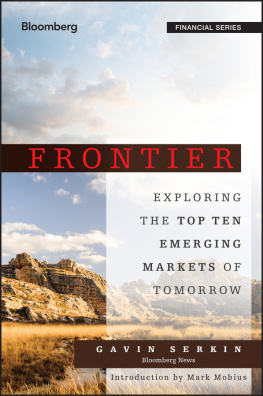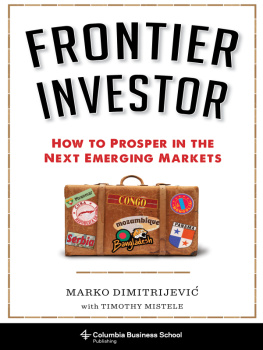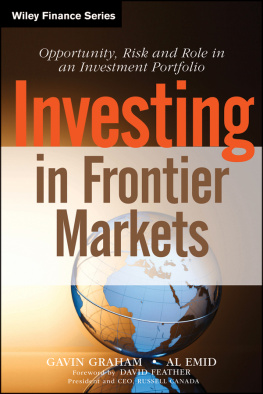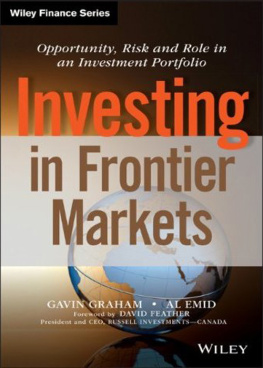Contents
Founded in 1807, John Wiley & Sons is the oldest independent publishing company in the United States. With offices in North America, Europe, Australia and Asia, Wiley is globally committed to developing and marketing print and electronic products and services for our customers professional and personal knowledge and understanding.
The Wiley Finance series contains books written specifically for finance and investment professionals as well as sophisticated individual investors and their financial advisors. Book topics range from portfolio management to e-commerce, risk management, financial engineering, valuation and financial instrument analysis, as well as much more.
For a list of available titles, visit our Web site at www.WileyFinance.com .

Copyright 2013 by John Wiley & Sons Singapore Pte. Ltd.
Published by John Wiley & Sons Singapore Pte. Ltd.
1 Fusionopolis Walk, #0701, Solaris South Tower, Singapore 138628
All rights reserved.
No part of this publication may be reproduced, stored in a retrieval system, or transmitted in any form or by any means, electronic, mechanical, photocopying, recording, scanning, or otherwise, except as expressly permitted by law, without either the prior written permission of the Publisher, or authorization through payment of the appropriate photocopy fee to the Copyright Clearance Center. Requests for permission should be addressed to the Publisher, John Wiley & Sons Singapore Pte. Ltd., 1 Fusionopolis Walk, #0701, Solaris South Tower, Singapore 138628, tel: 6566438000, fax: 6566438008, e-mail: .
Limit of Liability/Disclaimer of Warranty: While the publisher, author and contributors have used their best efforts in preparing this book, they make no representations or warranties with respect to the accuracy or completeness of the contents of this book and specifically disclaim any implied warranties of merchantability or fitness for a particular purpose. No warranty may be created or extended by sales representatives or written sales materials. The advice and strategies contained herein may not be suitable for your situation. You should consult with a professional where appropriate. Neither the publisher, authors or contributors shall be liable for any loss of profit or any other commercial damages, including but not limited to special, incidental, consequential, or other damages.
Investment Disclaimer: Information, data and opinions articulated by the contributors are personal and do not necessarily reflect the institutional views of any company they are associated or affiliated with. The content provided is not intended to serve as investment advice and shall not constitute an offer to subscribe, sell or purchase related securities or constitute the solicitation of an offer to buy or invest in securities offered or advised by any of the companies or their affiliates whose employees or associated individuals have contributed to this publication. Predictions or forecasts described or implied, may prove to be wrong and should not be relied upon. Risk diversification discussed does not imply lower risk or the ability to control risk. Any investment decision consequential to reading this book requires independent due diligence and investment advice by licensed professionals.
Other Wiley Editorial Offices
John Wiley & Sons, 111 River Street, Hoboken, NJ 07030, USA
John Wiley & Sons, The Atrium, Southern Gate, Chichester, West Sussex, P019 8SQ, United Kingdom
John Wiley & Sons (Canada) Ltd., 5353 Dundas Street West, Suite 400, Toronto, Ontario, M9B 6HB, Canada
John Wiley & Sons Australia Ltd., 42 McDougall Street, Milton, Queensland 4064, Australia
Wiley-VCH, Boschstrasse 12, D-69469 Weinheim, Germany
ISBN 9781118247174 (Cloth)
ISBN 9781118247204 (ePDF)
ISBN 9781118247198 (Mobi)
ISBN 9781118247181 (ePub)
To my wife, Michelle, thank you .
To our daughter Manon and son Dorian ,
happy investing .
Preface
It is foolish to assign any permanence to current economic balances, growth patterns, or trajectories. Very fundamental event risks are systemic. Yet it would be equally foolish to miss early opportunities afforded by the inevitable rebalancing of the global economy .
Investing in developing markets, including emerging and frontier economies as well as some unclassified investment destinations, is a broad subject that cannot be treated adequately in one book. It covers public and private securities (direct investments), debt and equity, large and small investments. They all are very different and all deserve much consideration on their own. We have therefore taken an inductive approach to elaborate on some of the more unusual aspects of developing markets investing to provide the ingredients for a holistic view on the subject.
The objective of this book is that in 5 or 10 years, you may still want to read certain contributions and refer to some market selections. This book is not meant as a short-term perspective or investment guide, but as a long-term view of what will become a necessity for every investor.
If you believe statements of the leading investment bank if at all. This will cause an overinvestment problem and largely miss the current rebalancing of the global economy.
We rather believe the sum of around 50 to 60 economies, each below 0.5 percent of global GDP, with huge endowments in natural and human resources and often adequate financial reserves, will individually and collectively have a very significant impact on global trade, consumer developments, and business activity and therefore are investable markets to consider. Moreover, regionalization will give those economies new impetus to grow and prosper and their political voice will increase. Far from sidelined, they will gradually increase their share of attention and in many cases deservedly so.
This book is for those who agree that it may take another few years, possibly longer, before the true impact of smaller, less-developed economies is fully appreciated. As investors, you do not want to wait until the future is history; now is the time to reflect and act.
On such a broad subject there cannot be only one view. Thus a number of contributors who have experience and insights into the trajectory of developing markets and are not hypnotized by China, India, or some of the other mega-economies are included. Undoubtedly, China will dominate the global economy in size and impact, but they will face as many issues down the road as the United States and Europe are confronting today.
Elephant hunting is not the only solution for the rational investor. Being nimble and alert is often the better play. To adopt a stratagem of The Art of War (Sun Tzu), when all investors target the relatively big markets and they become more expensive, the rational investor will be nimble and fast and target the less popular opportunities. This we argue throughout this book to the extreme of talking about Lao PDR, the Kingdom of Cambodia, or even Haiti as a possible investment destination in a timeframe of a few years to a generations lifetime.
Parts of this book are written from the perspective of a private equity investor (direct investments) because private equity investors are less concerned about the initial stock market framework or comparative analytics from a Bloomberg/Reuters screen and more about the specific investment and its value creation. They are more adventurous and find more interesting investment opportunities; they tend to outperform more passive public equity investors. Much can be learned and in developing economies even listed companies often present themselves and behave in way that is better suited to the assessment and approach of private equity investors.







